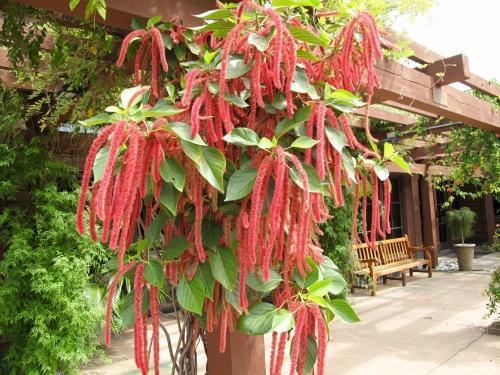Spectacular handsome amaranth tailed in your flowerbed
 Tailed amaranth is a herb from the amaranth family. This beautiful decorative flowering annual can often be found in flower beds due to its spectacular flowering. In addition, it is quite unpretentious and completely independent, since it grows well without additional care. For gardeners who rarely visit their summer cottages, amaranth is the most suitable plant. At a time when other flowers can wither in anticipation of the owner, amaranth retains its beauty, practically unchanged.
Tailed amaranth is a herb from the amaranth family. This beautiful decorative flowering annual can often be found in flower beds due to its spectacular flowering. In addition, it is quite unpretentious and completely independent, since it grows well without additional care. For gardeners who rarely visit their summer cottages, amaranth is the most suitable plant. At a time when other flowers can wither in anticipation of the owner, amaranth retains its beauty, practically unchanged.
What is a flower?
Grows amaranth the tailed rather tall bush, the height of a powerful erect stem reaches 1.5 m. The leaves are also large, elongated, with a purple tint, hanging slightly to the ground.
The plant also has other names, most often it is called a scythe, and also a cock's comb or a fox's tail.
At the beginning of summer, interesting inflorescences appear on the bush: small flowers are collected in long panicles that hang from the stem, resembling tails (this is reflected in the name of the flower). Their length can reach 0.5 m.
It is noteworthy that the inflorescence-tails retain their beauty until the very frost, and they are also used to make bouquets in a dried form.
Most often, the color of amaranth inflorescences is red, but other plant forms can be found in flower beds:
- Rothschwants with dark red flowers;

- Grunschwanz with light green tails.

Growing features
Amaranth reproduces well by self-sowing, but in order to cultivate the planting, seeds are harvested in autumn, and in spring they are planted in two ways to choose from:
- Sowing directly into open ground... Seeds should be sown on a flower bed no earlier than May, when return frosts will take place. Planting depth - no more than 3 cm, it is advisable to sprinkle with sand on top and press down slightly so that small seeds are not blown out by the wind. The grown bushes are planted, if necessary, leaving a distance of at least 40 cm.
- Sowing on seedlings... Amaranth can be sown in a greenhouse as early as March. After the formation of a pair of true leaves, the seedlings dive into separate pots, and in May they are planted in a flower bed.
Regardless of where the seeds are sown, after the seedlings have grown a little, they must be pinched so that the plants begin to branch.
Amaranth prefers well-lit areas with loose and nutritious soil. To prevent the wind from breaking the tall stem, you need to tie it to a support. The plant should be watered abundantly, but not very often, it does not like waterlogging. Since the flower is very thermophilic, it does not tolerate wintering in the open ground and, as a garden plant, is an annual that needs to be planted annually. Amaranth can also be grown as a pot culture. In this case, he needs a transplant every two years.